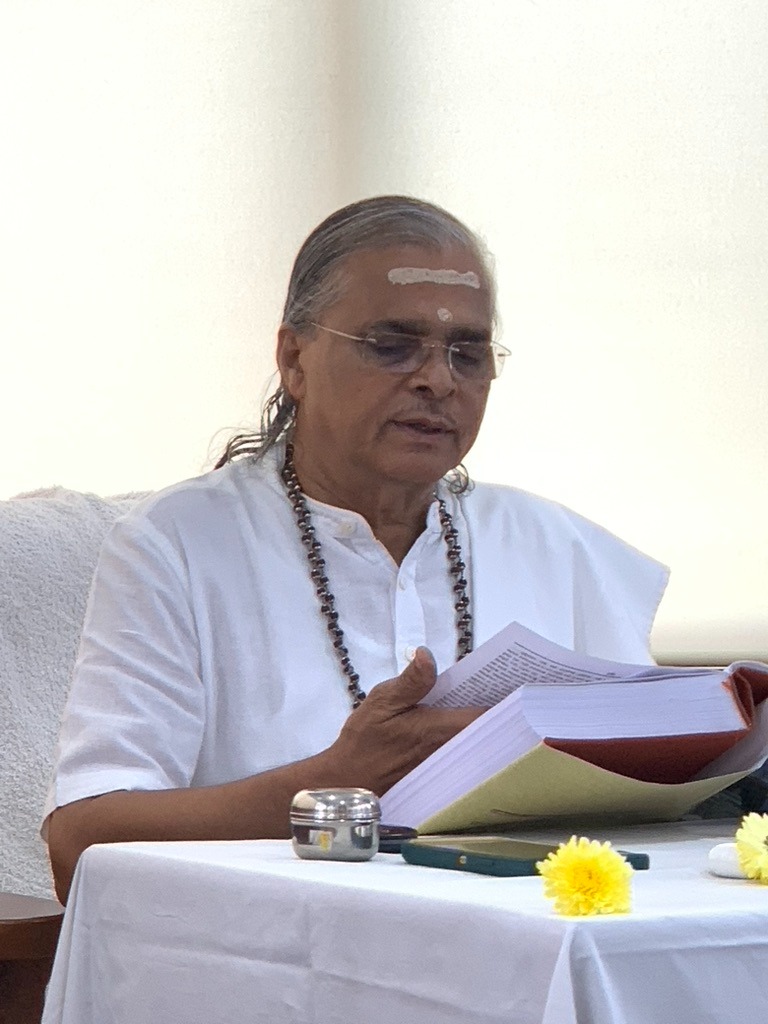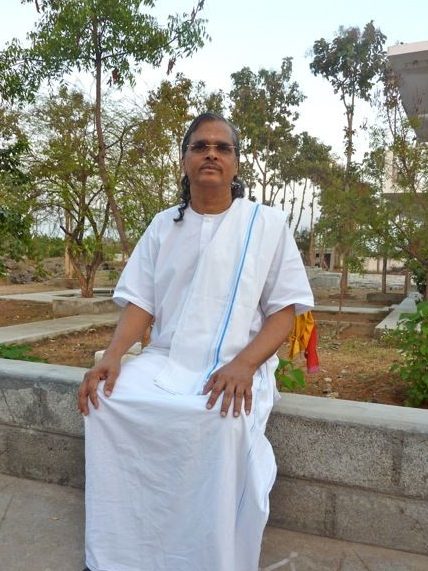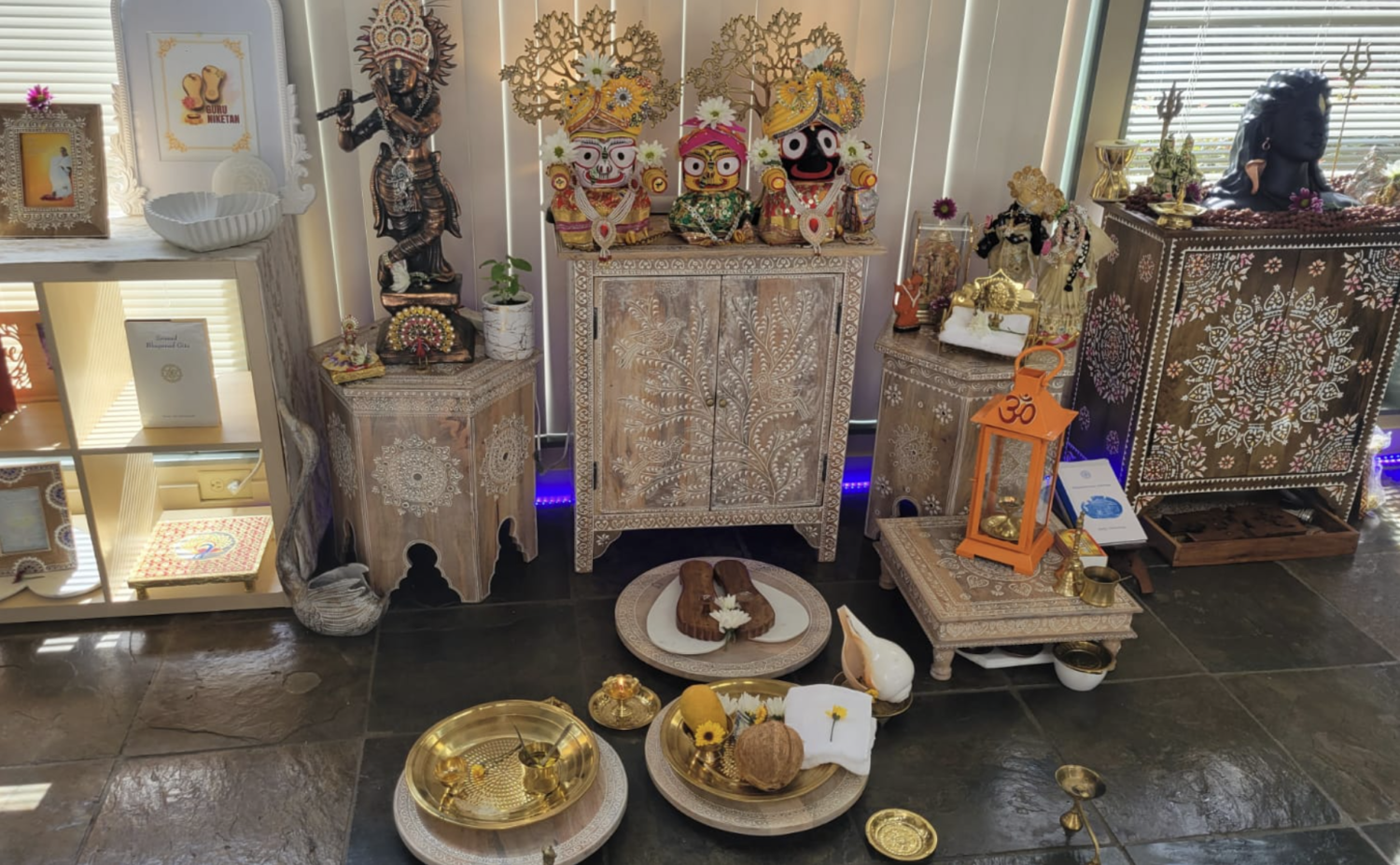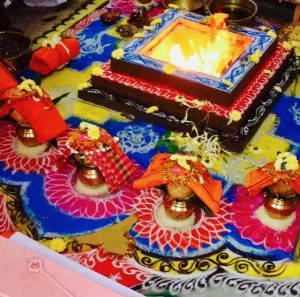Omm Namo Bhagavate Vasudevaya

There are three stages in the life of a yogi, a sincere awakened seeker. The first stage is when he feels he is doing sadhana and making progress. Next phase is when he feels he is not making any progress—he is either stuck up somewhere, or has entered into some zone where he cannot evaluate or know what is happening. In the third phase he feels there is no need of any more sadhana, or he may feel that the sadhana he was doing so far is not adequate, and he has to change the gear, and do something higher. These are very common experiences of yogis.
One who feels, “I am doing sadhana” and is conscious of what he is doing and of his inner progress, is in the beginning stage of yoga. When a seeker is awakened to the inner call and enters into a path, he goes through a process, and the first stage of this process, the first sign of this processing, is that the seeker will be always aware of his progress. He will be able to discriminate and evaluate. For example, he will be able to know, “Before when I was sitting quietly my mind was very turbulent, but now at least I am able to feel the silence.” Or he may feel, “Before when I was trying to go deeper, I was only able to reach the silence level, but never I was able to lose the body consciousness. Now I am able to lose that, and my awareness of the time. So I am going beyond time and space.” That is the samadhi experience he is having.
At the beginning stage he will also be able to know if he falls down: “Oh, I have fallen, I became a victim of misplaced compassion, a victim of ignorance, a victim of attachment; I got identified with doership, with result: I was trapped by the process of action.” In the very beginning stage he will be able to know that he is making progress and he will not only be conscious of this, he can consciously feel the progress. When sadhana advances farther, then only the seeker will be able to know where he is falling or getting trapped or something went wrong. These are the two stages of sadhana for a beginner seeker. Whether a beginner of one month or ten years, if the experience is within this zone I call it the beginner stage.
Then comes the second stage of sadhana, when the seeker feels he is not making any progress at all, but he does not feel that he is stuck up. It is very delicate. He will not feel that he has fallen, but he feels, “Consciously I am doing nothing. I am not doing sadhana the way I was earlier, I am not having the feelings of this deep state that I was having before. What is happening to me?” He may conclude that he is no more doing sadhana, but this is a higher stage—much, much higher than the beginning stage.
Only when one goes to a higher stage will one be able to sometimes get this type of feeling, “I am not doing any sadhana anymore.” That means he has reached a very high stage, when the “I,” the seeker, is absent. The seeker and the seeking have become one. It is like an airplane that takes off, and the passenger inside is able to feel that the airplane is gaining height. Although he cannot say how much height he has gained, he can feel it: “Yes, it is gaining height, I am going higher and higher.” But when the airplane has reached its altitude, and keeps flying at the same speed and the seat belt sign is turned off, the passenger does not feel even the movement of the airplane. That shows the airplane is at the desired altitude and speed. At that velocity it may appear to a passenger who is sitting inside the airplane that neither it is gaining height, nor it is moving forward, but actually the airplane is safely in its orbit and is flying at a high speed. It is just a matter of time when the plane will reach the destination and make preparation to land. When it is flying at the highest speed and the highest altitude, that is the time when the passenger can’t feel anything.
Similarly, in the second stage of sadhana the seeker will not feel that he is performing any sadhana, but the practice goes on. He is not doing it consciously. It is like a spontaneous response or a habit. It may appear sometimes as mechanical ritual, but if the practice is stopped the seeker feels uncomfortable. For example, if a person has entered the second stage and his habit is to every day sit for meditation at a particular time, or come for chanting or render some service, depending on what type of yoga one is following.
Gita has spoken of four paths, and one is the path of dhyana. Such a seeker who has picked up the habit of meditating at a particular time, if he is not meditating, he does not feel guilty but he feels uncomfortable, like something is not functioning properly. That type of uneasiness will come. But when he sits and meditates then he feels refreshed. It is like after you are exposed to dust and dirt and you take a shower and feel clean. That is the feeling that comes. If they don’t meditate at the right time they feel uncomfortable, but they don’t feel guilty if it was due to some outer compulsion. In the first stage, however, even if there is outer compulsion and sadhana could not be done, the seeker feels guilty, irritated, sad and angry. In the second phase the seeker does not feel guilty, nor he finds fault with anybody due to his lack of practice at the appointed hour. That is a higher stage.
Of the four paths Gita has shown, the path I followed is sankhya yoga, that is vichara, the contemplation. When I began my sadhana, if I was not able to contemplate for some time on a concept on Gita and the day was finished, I felt miserable. This is the reason I always wanted to be left alone. Even if I was surrounded by a group of friends, and they were talking on different desultory concepts, jumping from one topic to another to another, and that was not allowing me to contemplate, what would I do? Initiate an interesting discussion, and when all of them became fully involved in that, I would simply withdraw. Although sitting there, simply nodding my head—yes, yes, no, no—but actually I was busy in my contemplation, because I have never advertised my sadhana, nor my path. Never.
By seeing me outwardly no one could have guessed that this form was doing intense yoga practice. Neither I would regularly go to a temple nor visit an ashram, nor maintain any outer ritual of fasting or pilgrimage, nothing. Yet my sadhana was very intense and it was the sadhana of Gita, that is sänkhyenayogena, the contemplative method. One concept, one word or one chapter of Gita, my contemplation would continue, whether I was riding a bicycle or moving in a train or sitting in a bus or taking food. I would go deeper and deeper, newer and newer meanings would come, then I would apply it to my day-to-day experience: “Am I there? How long will I take to reach there? Will it be possible in this life?” This is how my sadhana was proceeding. Next, karmayogena chäpare, karma yoga. Yogic action. When my contemplative stage finished, I was promoted to the yogic action plane. That period lasted almost seven years, when I was consciously performing action and evaluating whether I got trapped by doership, result motive or the process.
In this second stage, which is a very high stage, the seeker sometimes will not be able to know that sadhana is actually going on. Outer life may appear as just mechanical and ritualistic: “Oh, every day doing invocation, every day chanting, sitting just mechanically for meditation, but nothing new is being gained.” However such a stage will come only when the airplane is flying at the highest altitude and speed. If someone is at that stage, then he simply has to relax, but keep up this practice that appears to be mechanical, ritualistic and meaningless. Just because you are not feeling that the plane is flying or gaining altitude, you should not think that it is stationary in space and try to open the door. That will invite disaster. How can one be sure that he has reached that stage? The outer practice will be spontaneous. There is no compulsion but the person is unconsciously driven towards it, and if there is a continuous lack of outer practice, continuously he will feel uncomfortable. He will not feel sad, nor bad, but he will not feel the bliss. That is the symptom.
Then there is a third stage, when a seeker feels that no longer there is any need for sadhana. That is the stage when I say the seeker has completely entered into the trap of yogamaya. A feeling will come, “There is no need of any sadhana for me. I have attained everything, I know everything, and now I am capable of guiding everyone.” This feeling will come only when the seeker is fully trapped inside. It is just a matter of time when such a seeker will completely fall. This fall is accelerated by the dark forces when the seeker feels to go in his own way, or to change the track. He may say, “This is my sadhana,” or, “This is not the right path I am following, I may go to this other path.” That means he is completely within the shooting range of the dark forces. Gita says, Swadharme nidhanamshreyah paradharmo bhayävahah: it is better to die while pursuing your own path. Don’t be allured to other paths, because that is very dangerous.
In the first phase of sadhana, practice is essential. Without practice you cannot feel your progress. In the second phase, just keep going, keep going, keep going. That is the eighteenth chapter of Gita, yajñadäna tapahkarma… pävanäni manïshinäm. Yajña, dana and tapasya, this is that so-called ritualistic, mechanical practice which does not give you any new feeling. It is purifying in nature and sustains your speed, so you should continue. Nishchitam matamuttamam, Lord Krishna says it is his considered opinion that this should never be given up.
Many of you might not have reached the stage when you can directly communicate with the Krishna the way I am doing. But you are having also the same privilege and fortune to receive this. How? If you ask me. If a seeker feels that he has a guide or a guru, for him the guru is Krishna, Rama, Jesus, Buddha. If you don’t ask me any sadhana-related question, why should I volunteer?
I am teaching you the principle of karma. Any action started from your side is karma, and any response you are giving to a signal is not karma. That will not bind you; that is manifestation. So if you are not asking me and I am seeing that you are interested in some other thing, why should I create a karma by volunteering my advice? This is why if someone says, “I don’t feel to go for chanting,” my answer is, “Don’t go.” If someone says, “I don’t feel any join in invocation,” I say, “Don’t.” What am I doing? I am not actually giving any answer. I am simply responding to you with what you want to hear. If you will change your question pattern—“Swamiji, before I was feeling joy for this, but now I am not feeling it, am I on the right track? Could you please guide me?”—then my answer will come.
If you are not having your link with the unmanifest, and you have cut your link with the manifest—that is, the form may be there, but you are no longer the seeker—what are you then? You are the social being or the material being. Then if you are the material being, why should I be a spiritual being for you? If you are the social being, why should I be a gunatit being for you? Try to understand. When I gone from Earth, there will be none who will make it so clear. I am not only giving you jñäna, I am living that life every moment. Why should I be anyone’s father, husband, or friend? I am I, the all-pervading consciousness, the all-pervading force and the all-manifesting energy. That is what I feel I am.
If you are not trying to reach I, the all-pervading force, energy and love, then why should I impose on you? Wind is blowing everywhere, but wind never imposes it on you. Now think, if this wind will impose even point-one percent on you, you will become powder. So much force is there in the wind. That is why God never imposes, and guru is always a witness. God simply responds the way you want to be responded to; yeyathämäm prapadyante tämstathaiva bhajämyaham. You make God your beloved, he will be your lover. Make God your father, he will protect you. Make God your friend, he will be friendly. If you feel God is your master, he will be demanding service. Everything originates from you only. The way you want it, God will grant it. That is God.
Guru is either the witness or intervening, and will intervene only when you surrender. This word surrender is applicable only to guru, not to God. When Krishna says, “Surrender to Me,” that time Krishna is playing the role of the guru: “Surrender to Me. I shall liberate you from all sin, grieve not.” It is guru. God does not care whether you are coming to samsar for a million births. God as prakriti brings you, God as purusha liberates you, and God as purusha is guru. If you do not want it, God will never impose, nor guru will intervene. Guru will be a witness. If the seeker in you is not there, the guru in me will simply witness, or the God in me will be only granting. Remember, guru grants nothing. Guru takes away everything. God grants everything; God is never a witness. Guru is never a giver. Guru simply takes you beyond.
Those are the three states that the seeker experiences. The first is the beginning, and the second is the very high stage, where one should maintain that velocity, nothing else. The third is extremely dangerous. All those who have remained in ashram, or in our centers, and developed disinterestedness for our path of sadhana, they have not lasted. It is just a matter of time until such people go. Why? Because this is the path, this is the sadhana. If this path has become meaningless, do you think I am such a foolish person that I myself come and continue the same thing? If the war is over, will Krishna on the nineteenth day again prepare his chariot and? No, because the war is already over. If the master is continuing the practice, how could you feel sadhana is no longer necessary for you? If the mother is busy in the kitchen, how can the child say, “I have no need for food?” Mother does not pay any attention, because she knows it is matter of another hour or two when he will suddenly come and scream for food.
All of you are in these categories. Some are in first category, some in the second and some in the third. Some of you are with me soul to soul, heart to heart, some are with me only through mind, and some are with me only through body, means physically they are with me. Whenever any such feeling, or any such thought is coming, you have to remember what I am saying. If you are in the first stage, my advice is never give up, continue the practice. If you give up the practice, you can never go to the second phase. If you are in the second phase, even if you feel you are doing no sadhana, still be inside the airplane. It is just a matter of time when you will land at the destination. If you are in the third phase, God save you.
[From a 2010 Interaction at Satyachetana Ashram, Tiruvannamalai, India.]







